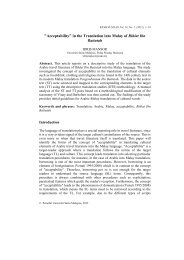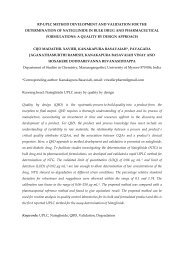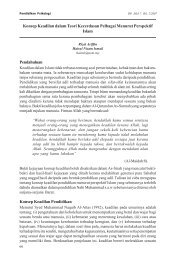Isolation, Identification and Molecular Characterization of Rare - USM
Isolation, Identification and Molecular Characterization of Rare - USM
Isolation, Identification and Molecular Characterization of Rare - USM
You also want an ePaper? Increase the reach of your titles
YUMPU automatically turns print PDFs into web optimized ePapers that Google loves.
Mal. J. Microbiol. Vol 8(2) 2012, pp. 83-91<br />
(Eppendorf, Germany). Each reaction mixture contained 1<br />
µL <strong>of</strong> DNA, 1 µL <strong>of</strong> 10 pmol forward 16S Actino specific<br />
primer (5´-AAATGGAGGAAGGTGGGGAT-`3); 1 µL <strong>of</strong> 10<br />
pmol reverse 16S Actino specific primer (5´-<br />
AGGAGGTGATCCAACCGCA-`3); 25 µL <strong>of</strong> Master Mix<br />
<strong>and</strong> 22 µL <strong>of</strong> molecular grade nuclease free water.<br />
The separation was carried out at 90 Volts for 40 min in<br />
TAE buffer with 5 µL <strong>of</strong> Ethidium bromide (Messner et al.,<br />
1994). PCR product was analysed using 1 % agarose<br />
gel <strong>and</strong> the fragment was purified (Helini Pure Fast PCR<br />
clean up kit, Helini Bio molecules, India) according to the<br />
manufacturer instructions. The b<strong>and</strong>s were analyzed<br />
under UV light <strong>and</strong> documented using Gel Doc. The direct<br />
sequencing <strong>of</strong> PCR products was performed by dideoxy<br />
chain termination method using 3100-Avant Genetic<br />
Analyzer (Applied Bio systems, USA). The obtained<br />
sequences were analyzed for homology using BLASTN<br />
(Entrez Nucleotide database).<br />
Nucleotide Sequence Accession Numbers<br />
The 16S rRNA gene (rDNA) sequences <strong>of</strong> the strain VUK<br />
-10 are registered in the GenBank database with the<br />
accession number.<br />
Extraction <strong>of</strong> Antimicrobial Metabolites<br />
The inoculum was prepared by suspending spores from<br />
one week old culture (Yeast extract malt extract dextrose<br />
agar) in 10 mL <strong>of</strong> sterile saline. 5 mL <strong>of</strong> the homogenous<br />
spore suspension was used to inoculate 50 mL <strong>of</strong><br />
asparagines-glucose broth (seed medium) in a 250 mL<br />
Erlenmeyer flask, <strong>and</strong> the culture was incubated at 30 °C<br />
for 48 h on a rotator shaker at 120 rpm. Seed culture at<br />
the rate <strong>of</strong> 10 % was transferred into 500 mL <strong>of</strong> starch -<br />
casein broth (Fermentation medium). The fermentation<br />
was carried out at 28±2 °C for 96 h under agitation at 120<br />
rpm. Antimicrobial compound was purified from the filtrate<br />
by solvent extraction method. Ethyl acetate was added to<br />
the filtrate in the ratio <strong>of</strong> 1:1 (V/V) <strong>and</strong> shaken vigorously<br />
for 1 h for complete extraction. The ethyl acetate phase<br />
that contains bioactive metabolites was separated from<br />
the aqueous phase. It was evaporated to dryness in water<br />
bath <strong>and</strong> residue obtained was used to determine<br />
antimicrobial activity by agar well diffusion method<br />
(Cappuccino <strong>and</strong> Sherman, 2004) <strong>and</strong> effectiveness was<br />
measured by zone <strong>of</strong> inhibition.<br />
RESULTS AND DISCUSSION<br />
The present study was designed to investigate the<br />
mangrove ecosystem <strong>of</strong> Nizampatnam for novel<br />
actinomycetes <strong>and</strong> their antimicrobial properties. During<br />
our continuous search for novel antimicrobial metabolites<br />
<strong>of</strong> Nizampatnam mangrove region led to the isolation <strong>of</strong><br />
morphologically distinct actinomycetes isolate VUK-10 on<br />
asparagine glucose agar media by employing soil dilution<br />
plate technique. The strain VUK -10 exhibited typical<br />
morphological characteristics <strong>of</strong> the genus<br />
Pseudonocardia (Warwick et al., 1994; Huang et al.,<br />
2002). Morphological <strong>and</strong> micro morphological<br />
observation <strong>of</strong> the strain revealed that aerial <strong>and</strong><br />
vegetative hyphae were abundant, well developed <strong>and</strong><br />
fragmented with rod shaped smooth surfaced spores.<br />
Soluble pigment production by the strain was not found on<br />
the culture media tested except melanin pigmentation on<br />
tyrosine (ISP-7) agar media.<br />
Cultural Characteristics<br />
The cultural characteristics <strong>of</strong> the strain are represented in<br />
Table 1. The strain VUK- 10 exhibited good growth on<br />
tryptone-yeast extract (ISP-1) agar, yeast extract-malt<br />
extract-dextrose (ISP-2) agar, oat-meal (ISP-3) agar,<br />
glycerol-asparagine (ISP-5) agar, czapek-dox agar <strong>and</strong><br />
maltose-tryptone agar. The growth was moderate on<br />
starch-inorganic salts (ISP-4) agar, tyrosine agar (ISP-7)<br />
<strong>and</strong> starch casein agar while it was poor on nutrient agar.<br />
Creamy white aerial mycelium was found on ISP-1, ISP -<br />
2, ISP-7, maltose tryptone <strong>and</strong> starch casein agar where<br />
as the aerial mycelium was cream colour in ISP-4, ISP-5<br />
<strong>and</strong> creamy orange in czapek-dox agar. No aerial<br />
mycelium was formed on nutrient agar medium. The<br />
substrate mycelium ranges from brownish orange (on ISP-<br />
1 <strong>and</strong> ISP-2) to brown (ISP-3, ISP-4, ISP-5 <strong>and</strong> ISP-7) or<br />
light orange (czapek-dox agar, maltose tryptone agar <strong>and</strong><br />
nutrient agar). Siva Kumar (2001) reported that the<br />
cultural characteristics could be used as markers by which<br />
an individual strain can be recognized.<br />
Physiological Characteristics<br />
The physiological tests are indispensable tools for<br />
classification <strong>and</strong> identification <strong>of</strong> actinomycetes <strong>and</strong><br />
influencing the growth rate <strong>of</strong> actinomycetes (Kampfer et<br />
al., 1991; Hasegawa et al., 1978; Kim et al., 1999 <strong>and</strong><br />
Shimizu et al., 2000). Growth <strong>of</strong> the strain VUK-10<br />
occurred in the pH range <strong>of</strong> 6-9 with optimum growth at<br />
pH 7. The temperature range for growth was 20-45 °C<br />
with the optimum temperature being 35 °C. The strain<br />
exhibited salt tolerance up to 10 % with optimum growth at<br />
3 % NaCl; hence, the strain could be placed in<br />
intermediate salt tolerance group according to Tresner et<br />
al. (1968).<br />
Biochemical <strong>Characterization</strong><br />
VUK-10 exhibited positive response to catalase<br />
production <strong>and</strong> citrate utilization but negative for urease,<br />
hydrogen sulphide production, nitrate reduction, starch<br />
hydrolysis, gelatine liquefaction, indole, methyl red <strong>and</strong><br />
vogues-proskauer tests. The details <strong>of</strong> morphological,<br />
physiological <strong>and</strong> biochemical characteristics <strong>of</strong> the isolate<br />
are given in (Table 2).<br />
Utilization <strong>of</strong> carbon sources by the strains could be used<br />
as an aid for species determination (Pridham <strong>and</strong> Gottlieb,<br />
1948). The strain VUK-10 efficiently utilized the carbon<br />
sources such as D-glucose, lactose, maltose, sucrose,<br />
85 ISSN (print): 1823-8262, ISSN (online): 2231-7538




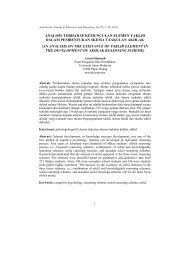
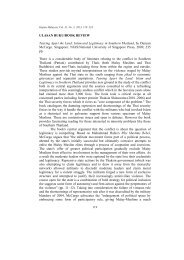

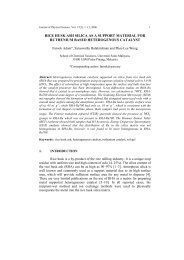

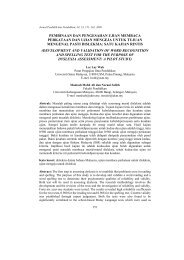
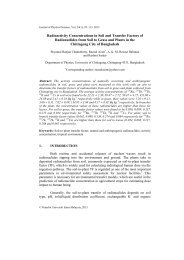
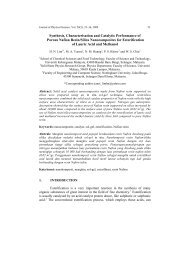

![KTT 111 – Inorganic Chemistry I [Kimia Takorganik I] - USM](https://img.yumpu.com/12405642/1/184x260/ktt-111-inorganic-chemistry-i-kimia-takorganik-i-usm.jpg?quality=85)
